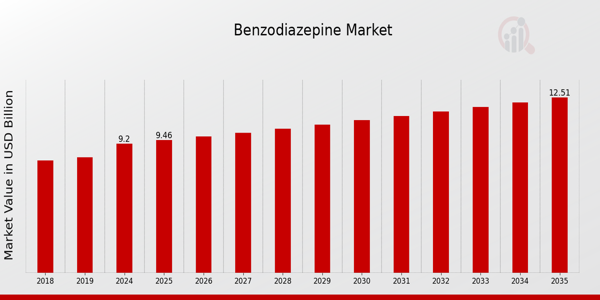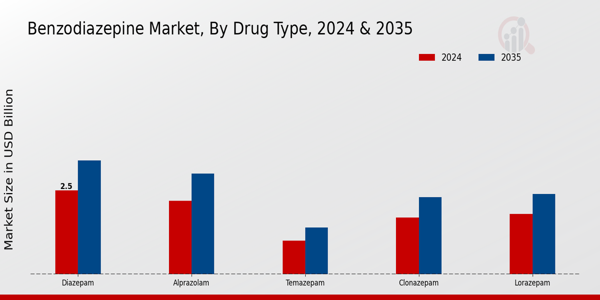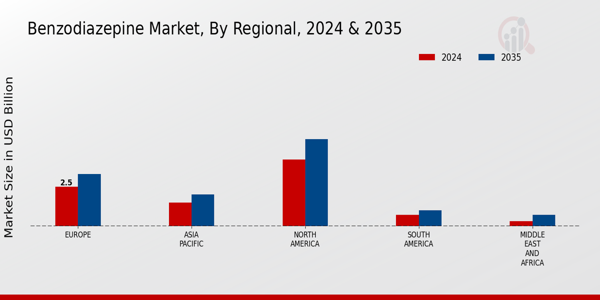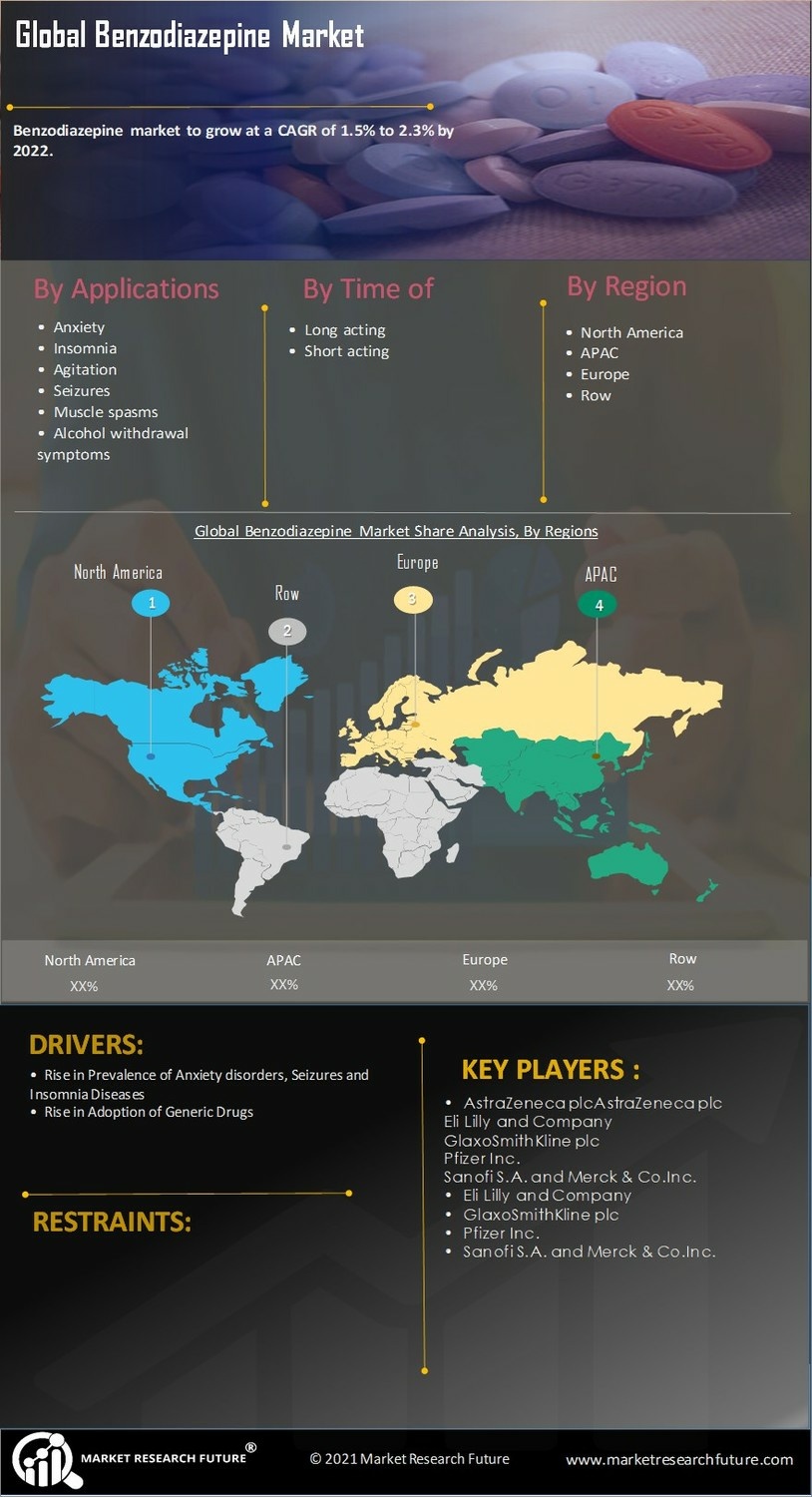Benzodiazepine Market Overview
As per MRFR analysis, the Benzodiazepine Market Size was estimated at 8.94 (USD Billion) in 2023. The Benzodiazepine Market is expected to grow from 9.2 (USD Billion) in 2024 to 12.5 (USD Billion) by 2035. The Benzodiazepine Market CAGR (growth rate) is expected to be around 2.83% during the forecast period (2025 - 2035).
Key Benzodiazepine Market Trends Highlighted
The growing frequency of anxiety and mood disorders, which have been identified by several international health organizations as serious public health concerns, is one of the main factors driving the present notable trends in the Benzodiazepine Market.
Access to benzodiazepines is more crucial than ever because of the rise in prescription rates for these drugs brought on by increased awareness of mental health issues, especially after the COVID-19 epidemic.
Additionally, the shift to patient-centered care is promoting the creation of customized drug regimens, which frequently involve the short-term use of benzodiazepines, helping to change the landscape of therapy. There are significant opportunities in the worldwide benzodiazepine market, particularly in areas with inadequate mental health services.
Patients without access to medical facilities can benefit immensely from the opportunity for telemedicine services to grow, which gives professionals a way to assess and prescribe benzodiazepines from a distance.
New approaches to medication formulation and distribution are also being developed with the goal of improving patient adherence and lowering the danger of long-term reliance, opening up new markets for producers.
Discussions concerning benzodiazepines and other treatment alternatives have increased recently as a result of efforts to lessen the stigma attached to mental health conditions. In order to change attitudes and raise demand for these therapies, public health campaigns that educate the public on the value of mental wellbeing are essential.
Furthermore, regulatory agencies are reviewing benzodiazepine prescription standards, which may change market dynamics as practitioners attempt to strike a balance between patient safety concerns and effective therapy. As the worldwide benzodiazepine industry adjusts to shifting societal and health demands, these changing patterns highlight a dynamic environment.

Source: Primary Research, Secondary Research, Market Research Future Database and Analyst Review
Benzodiazepine Market Drivers
Increasing Anxiety and Depression Rates
The growing prevalence of anxiety and depression globally is a significant driver for the Benzodiazepine Market. According to the World Health Organization (WHO), the global incidence of anxiety disorders has risen by approximately 25% over the last five years.
This rise is linked to various factors, including the ongoing effects of the COVID-19 pandemic, which has led to more individuals seeking medical intervention for mental health issues.
In addition, the American Psychological Association reports that more than 40 million adults in the United States experience anxiety disorders, driving up the demand for benzodiazepines as prescribed medications for their treatment. Such statistics indicate a clear potential for market expansion in response to increased mental health issues across the world.
Rising Geriatric Population
The aging population across the globe significantly influences the growth of the Benzodiazepine Market. According to the United Nations, by the year 2050, the global population of people aged 60 years and older is projected to reach nearly 2.1 billion, up from 1 billion in 2019.
This demographic change increases the prevalence of age-related health issues such as anxiety, insomnia, and other stress-related disorders, which often require benzodiazepine treatment.
With organizations like the World Health Organization emphasizing the importance of addressing mental health within older adults, the demand for these medications is expected to rise correspondingly, thereby propelling market growth.
Ongoing Research and Development Initiatives
Innovations in drug formulation and delivery systems are vital for the advancement of the Benzodiazepine Market. A surge in Research and Development (R&D) initiatives among pharmaceutical companies is focused on developing new formulations of benzodiazepines that offer improved safety profiles and lower addiction potential.
For instance, the Food and Drug Administration (FDA) has been actively involved in approving new benzodiazepine drugs that utilize novel delivery methods.
These new advancements not only improve patient outcomes but also align with regulatory trends aimed at reducing misuse and dependency on these medications. Therefore, the ongoing investment in R&D serves as a foundational driver of market growth as businesses strive to meet evolving patient needs.
Benzodiazepine Market Segment Insights
Benzodiazepine Market Drug Type Insights
The Benzodiazepine Market exhibited a clear segmentation within its Drug Type category, highlighting specific subtypes that catered to varying therapeutic needs.
Diazepam stood out as a leading drug, accounting for 2.5 USD Billion in 2024, and is expected to grow to 3.4 USD Billion in 2035, reflecting its significant role in the treatment of anxiety disorders and muscle spasms.
Lorazepam followed, holding a valuation of 1.8 USD Billion in 2024 and reaching 2.4 USD Billion in 2035, valued for its efficacy in severe anxiety situations and as a pre-anesthetic agent, which emphasizes its importance in clinical settings.
Alprazolam showcased its importance, with a market value of 2.2 USD Billion in 2024, expected to increase to 3.0 USD Billion in 2035; it was widely recognized for its effectiveness in managing panic disorders, which contributed to its substantial usage.
Clonazepam, with a valuation of 1.7 USD Billion in 2024 and projected to grow to 2.3 USD Billion by 2035, played a critical role in seizure control and anxiety, thereby securing its place in the market. Meanwhile, Temazepam, though comparatively smaller at 1.0 USD Billion in 2024 and expected to reach 1.4 USD Billion in 2035, remained significant for its application in treating insomnia.
The Benzodiazepine Market segmentation reflected not only distinctive drug importance but also shed light on the broader trends of increasing mental health awareness and a growing aging population, which drive the demand for these medications.
Each drug type fulfills vital roles in the healthcare system, with Diazepam and Alprazolam dominating market shares due to their prevalent use in various therapeutic treatments. This diversity in the Drug Type market aids in addressing broad patient needs and demonstrates the robust growth trajectory influenced by both clinical efficacy and increasing patient acceptance in global therapeutic practices.

Source: Primary Research, Secondary Research, Market Research Future Database and Analyst Review
Benzodiazepine Market Application Insights
Within the market, the application sector comprises significant areas such as Anxiety Disorders and Insomnia Treatment, reflecting major needs in modern society for effective management of stress and sleep disturbances. The prevalence of anxiety disorders has surged globally, making the treatment options in this segment critical.
Insomnia Treatment, essential for improving quality of life, is also a prominent area, with increasing awareness around sleep health boosting the demand.
Additionally, the use of benzodiazepines for Seizure Disorders underlines their necessity in emergency care, while Muscle Relaxants and Alcohol Withdrawal treatments lower withdrawal symptoms and muscle tension, contributing to the overall therapeutic landscape.
The Benzodiazepine Market segmentation illustrates a diverse product offering addressing multiple health challenges, driven by growing needs for effective medications and emerging trends in healthcare that prioritize patient-centric solutions.
This diverse application portfolio opens up numerous opportunities for market expansion, influenced by changing demographics and increased healthcare access across regions.
Benzodiazepine Market Route of Administration Insights
The Benzodiazepine Market is significantly influenced by the Route of Administration segment, which includes various methods such as Oral, Injectable, and Intranasal routes. The Oral route is particularly significant as it allows for easy self-administration, enhancing patient compliance.
Injectable forms are essential for acute care settings, offering rapid onset and high bioavailability, which is critical for effective treatment in emergencies. On the other hand, the Intranasal route is emerging as a preferred option for certain indications due to its swift absorption and convenience.
The Benzodiazepine Market revenue is affected by these factors, as healthcare providers increasingly focus on delivering medications effectively to optimize patient outcomes. With the ever-evolving landscape of pharmaceutical innovations and an uptick in mental health awareness, the demand for varied administration routes is expected to rise, offering ample opportunities for growth in the market.
Furthermore, challenges such as drug regulations and safety concerns will continuously shape the trends in the Benzodiazepine Market, emphasizing the need for ongoing Research and Development to enhance product offerings and patient safety.
Benzodiazepine Market End-user Insights
The Benzodiazepine Market has shown significant value, reflecting growing demand across various End-user settings. Hospitals are crucial as they provide critical care and acute treatment, often managing patients with severe anxiety, insomnia, or seizure disorders.
Clinics play a significant role by offering outpatient services and contributing to long-term management of conditions requiring benzodiazepines, leading to increased patient visits. Homecare settings have gained importance due to the rising trend of at-home treatment, particularly for the elderly and those with chronic conditions, catering to patients who prefer receiving care in the comfort of their homes.
The overall market is influenced by factors such as an aging population, rising mental health awareness, and regulatory shifts favoring accessible healthcare. However, challenges remain, including potential for misuse and dependency associated with benzodiazepine use.
The Benzodiazepine Market segmentation indicates a diversified landscape where the interplay between hospitals, clinics, and homecare settings shapes industry dynamics, ensuring that patients receive tailored treatments.
Benzodiazepine Market Regional Insights
The Benzodiazepine Market showed promising growth across various regions, with North America holding a majority share valued at 4.2 USD Billion in 2024 and projected to reach 5.5 USD Billion by 2035. This significant valuation underscored the region's robust healthcare infrastructure and high prevalence of anxiety disorders.
Europe followed with a valuation of 2.5 USD Billion in 2024, expected to grow to 3.3 USD Billion, driven by increased prescription rates and awareness regarding mental health. South America, with its value of 0.7 USD Billion, is anticipated to reach 1.0 USD Billion, reflecting growing healthcare access and evolving regulations surrounding psychiatric medications.
Meanwhile, the Asia Pacific region was valued at 1.5 USD Billion, projected to reach 2.0 USD Billion, where rising urbanization and initiatives to improve mental health are key drivers. The Middle East and Africa represented the smallest market with a valuation of 0.3 USD Billion, projected to grow to 0.7 USD Billion, influenced by developing healthcare systems and increasing attention to mental health.
Overall, the Benzodiazepine Market segmentation demonstrated varying strengths and opportunities for growth, with regional dynamics significantly impacting market trends and growth drivers.

Source: Primary Research, Secondary Research, Market Research Future Database and Analyst Review
Benzodiazepine Market Key Players and Competitive Insights
The Benzodiazepine Market presents a dynamic landscape characterized by myriad competitive forces, with key players vying for market share through innovation, regulatory compliance, and strategic initiatives.
The market is influenced by a variety of factors including the rising prevalence of anxiety disorders, insomnia, and other conditions where benzodiazepine medications are commonly prescribed. As pharmaceutical companies continue to advance their research and development efforts, the branding and differentiation of benzodiazepine products have become increasingly critical.
Moreover, the scrutiny surrounding the safety and misuse potential of benzodiazepines has prompted companies to adopt responsible marketing strategies while focusing on education about proper usage and potential risks. This framework of competitive insights sets the stage for a closer examination of notable companies in the market that are shaping its trajectory.
Novartis has established a significant presence in the Benzodiazepine Market, leveraging its extensive research and development capabilities to enhance its product offerings. The company's strengths lie in its robust pipeline of drugs aimed at treating anxiety and sleep disorders, which are often associated with benzodiazepine prescriptions.
Novartis is recognized for its commitment to innovation, resulting in the development of effective formulations that address both efficacy and safety concerns. The company emphasizes quality assurance and compliance with regulatory standards, creating a strong trust with healthcare providers and patients alike.
Furthermore, Novartis's strategic partnerships and collaborations with various stakeholders in the healthcare ecosystem further bolster its position within the Benzodiazepine Market, allowing it to expand its reach and enhance its portfolio.
Lundbeck, with its focus on brain health, is a prominent player in the Benzodiazepine Market, particularly specializing in the treatment of mood and anxiety disorders. The company's key products include various benzodiazepine formulations aimed at addressing the needs of patients struggling with these conditions.
Lundbeck's market presence is strengthened by its dedication to developing therapies that provide significant clinical benefits while prioritizing patient safety. The company has successfully navigated various mergers and acquisitions to expand its capabilities and product lines, thereby enhancing its competitive stance.
Lundbeck's commitment to ongoing research and development not only fuels innovation but also positions the company as a key contributor to advances in benzodiazepine therapies on a global scale. This focus on addressing unmet medical needs in mental health further solidifies Lundbeck's stronghold in the Benzodiazepine Market.
Key Companies in the Benzodiazepine Market Include
- Novartis
- Lundbeck
- Teva Pharmaceutical Industries
- Hikma Pharmaceuticals
- Mylan
- Sandoz
- Boehringer Ingelheim
- Pfizer
- Indivior
- AstraZeneca
- Acura Pharmaceuticals
- Eli Lilly
- Sanofi
- Roche
- AbbVie
Benzodiazepine Market Developments
The conditions for clinical licensing of benzodiazepines were strengthened by international pharmaceutical authorities in June 2025. The requirements included more stringent long-term safety data under Risk Evaluation and Mitigation Strategy (REMS) programs in the United States and comparable frameworks in Europe.
China's health officials raised midazolam to a higher control category in July 2024, necessitating full-chain traceability, improved licensing, and prescription oversight. Clonazepam was classed as a "black stripe" drug by Brazil's ANVISA in 2023, requiring specific prescription paperwork and real-time dispensing surveillance.
Due to supply chain issues between India and China, North American manufacturers reported ongoing shortages of active pharmaceutical ingredients (API) in early 2025, which slowed the production of generic benzodiazepines like lorazepam and diazepam.
Broadening access to short-term therapies for anxiety and sleeplessness while increasing regulatory monitoring, telemedicine platforms in the United States and Canada started dispensing restricted benzodiazepines under extended registration criteria in the middle of 2025.
In order to lessen the possibility of abuse, major companies including Pfizer, Teva, and Sun Pharma also expedited the introduction of safer, short-acting formulations and intranasal administration methods in 2025.
Sun Pharma's rapid-dissolve clonazepam was approved in India. Finally, when governments imposed tougher limits restricting usage to 2–4 weeks, prescription volumes decreased by around 18% throughout Europe and APAC in 2022–2025. This led to a move toward behavioral treatments and other anxiolytics.
Benzodiazepine Market Segmentation Insights
-
Benzodiazepine Market Drug Type Outlook
- Diazepam
- Lorazepam
- Alprazolam
- Clonazepam
- Temazepam
-
Benzodiazepine Market Application Outlook
- Anxiety Disorders
- Insomnia Treatment
- Seizure Disorders
- Muscle Relaxant
- Alcohol Withdrawal
-
Benzodiazepine Market Route of Administration Outlook
- Oral
- Injectable
- Intranasal
-
Benzodiazepine Market End-user Outlook
- Hospitals
- Clinics
- Homecare Settings
-
Benzodiazepine Market Regional Outlook
- North America
- Europe
- South America
- Asia Pacific
- Middle East and Africa
|
Report Attribute/Metric
|
Details
|
|
Market Size 2023
|
8.94(USD Billion)
|
|
Market Size 2024
|
9.2(USD Billion)
|
|
Market Size 2035
|
12.5(USD Billion)
|
|
Compound Annual Growth Rate (CAGR)
|
2.83% (2025 - 2035)
|
|
Report Coverage
|
Revenue Forecast, Competitive Landscape, Growth Factors, and Trends
|
|
Base Year
|
2024
|
|
Market Forecast Period
|
2025 - 2035
|
|
Historical Data
|
2019 - 2024
|
|
Market Forecast Units
|
USD Billion
|
|
Key Companies Profiled
|
Novartis, Lundbeck, Teva Pharmaceutical Industries, Hikma Pharmaceuticals, Mylan, Sandoz, Boehringer Ingelheim, Pfizer, Indivior, AstraZeneca, Acura Pharmaceuticals, Eli Lilly, Sanofi, Roche, AbbVie
|
|
Segments Covered
|
Drug Type, Application, Route of Administration, End-user, Regional
|
|
Key Market Opportunities
|
Rising prevalence of anxiety disorders, Growing geriatric population demands, Increased off-label uses for treatment, Expansion in emerging markets, Development of novel formulations.
|
|
Key Market Dynamics
|
increasing anxiety disorders prevalence, rising geriatric population, growing off-label uses, regulatory scrutiny on prescriptions, competition from alternative therapies
|
|
Countries Covered
|
North America, Europe, APAC, South America, MEA
|
Frequently Asked Questions (FAQ):
The Benzodiazepine Market was valued at 9.2 USD Billion in 2024.
By 2035, the Benzodiazepine Market is projected to reach a value of 12.5 USD Billion.
The expected CAGR for the Benzodiazepine Market from 2025 to 2035 is 2.83%.
North America held the largest market share, valued at 4.2 USD Billion in 2024.
The North American Benzodiazepine Market is projected to grow to 5.5 USD Billion by 2035.
Key players in the Benzodiazepine Market include Novartis, Lundbeck, Teva Pharmaceutical Industries, and Pfizer.
Diazepam held the highest market value, projected at 2.5 USD Billion in 2024.
The market size for Clonazepam was valued at 1.7 USD Billion in 2024.
The market for Lorazepam is expected to grow to 2.4 USD Billion by 2035.
The Asian Pacific region's Benzodiazepine Market is projected to reach 2.0 USD Billion by 2035.

















